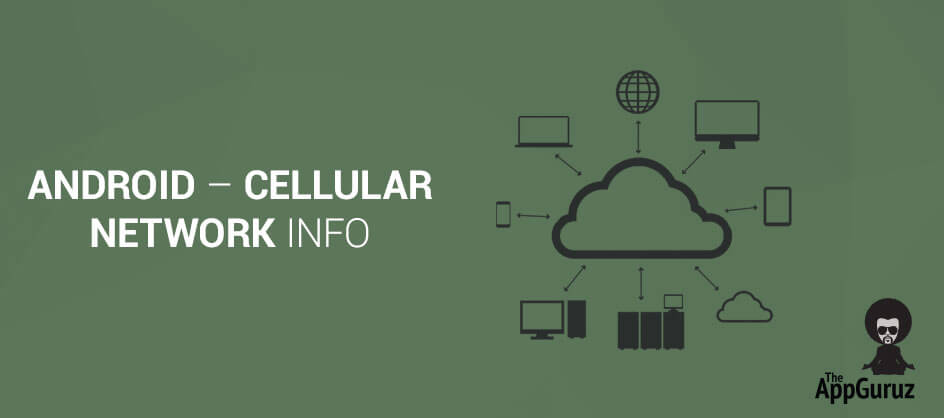
Be patient..... we are fetching your source code.
Objective
Main objective of this tutorial is to help you to get Cellular Network information.
Step 1 Create Connectivity Class
First we create new class in our Android Project named Connectivity. This Class used for checking the Cellular Network Information.
public class Connectivity {
/*
* These constants aren't yet available in my API level (7), but I need to
* handle these cases if they come up, on newer versions
*/
public static final int NETWORK_TYPE_EHRPD = 14; // Level 11
public static final int NETWORK_TYPE_EVDO_B = 12; // Level 9
public static final int NETWORK_TYPE_HSPAP = 15; // Level 13
public static final int NETWORK_TYPE_IDEN = 11; // Level 8
public static final int NETWORK_TYPE_LTE = 13; // Level 11
/**
* Check if there is any connectivity
*
* @param context
* @return
*/
public static boolean isConnected(Context context) {
ConnectivityManager cm = (ConnectivityManager) context
.getSystemService(Context.CONNECTIVITY_SERVICE);
NetworkInfo info = cm.getActiveNetworkInfo();
return (info != null && info.isConnected());
}
/**
* Check if there is fast connectivity
*
* @param context
* @return
*/
public static String isConnectedFast(Context context) {
ConnectivityManager cm = (ConnectivityManager) context
.getSystemService(Context.CONNECTIVITY_SERVICE);
NetworkInfo info = cm.getActiveNetworkInfo();
if ((info != null && info.isConnected())) {
return Connectivity.isConnectionFast(info.getType(),
info.getSubtype());
} else
return "No NetWork Access";
}
/**
* Check if the connection is fast
*
* @param type
* @param subType
* @return
*/
public static String isConnectionFast(int type, int subType) {
if (type == ConnectivityManager.TYPE_WIFI) {
System.out.println("CONNECTED VIA WIFI");
return "CONNECTED VIA WIFI";
} else if (type == ConnectivityManager.TYPE_MOBILE) {
switch (subType) {
case TelephonyManager.NETWORK_TYPE_1xRTT:
return "NETWORK TYPE 1xRTT"; // ~ 50-100 kbps
case TelephonyManager.NETWORK_TYPE_CDMA:
return "NETWORK TYPE CDMA (3G) Speed: 2 Mbps"; // ~ 14-64 kbps
case TelephonyManager.NETWORK_TYPE_EDGE:
return "NETWORK TYPE EDGE (2.75G) Speed: 100-120 Kbps"; // ~ 50-100 kbps
case TelephonyManager.NETWORK_TYPE_EVDO_0:
return "NETWORK TYPE EVDO_0"; // ~ 400-1000 kbps
case TelephonyManager.NETWORK_TYPE_EVDO_A:
return "NETWORK TYPE EVDO_A"; // ~ 600-1400 kbps
case TelephonyManager.NETWORK_TYPE_GPRS:
return "NETWORK TYPE GPRS (2.5G) Speed: 40-50 Kbps"; // ~ 100 kbps
case TelephonyManager.NETWORK_TYPE_HSDPA:
return "NETWORK TYPE HSDPA (4G) Speed: 2-14 Mbps"; // ~ 2-14 Mbps
case TelephonyManager.NETWORK_TYPE_HSPA:
return "NETWORK TYPE HSPA (4G) Speed: 0.7-1.7 Mbps"; // ~ 700-1700 kbps
case TelephonyManager.NETWORK_TYPE_HSUPA:
return "NETWORK TYPE HSUPA (3G) Speed: 1-23 Mbps"; // ~ 1-23 Mbps
case TelephonyManager.NETWORK_TYPE_UMTS:
return "NETWORK TYPE UMTS (3G) Speed: 0.4-7 Mbps"; // ~ 400-7000 kbps
// NOT AVAILABLE YET IN API LEVEL 7
case Connectivity.NETWORK_TYPE_EHRPD:
return "NETWORK TYPE EHRPD"; // ~ 1-2 Mbps
case Connectivity.NETWORK_TYPE_EVDO_B:
return "NETWORK_TYPE_EVDO_B"; // ~ 5 Mbps
case Connectivity.NETWORK_TYPE_HSPAP:
return "NETWORK TYPE HSPA+ (4G) Speed: 10-20 Mbps"; // ~ 10-20 Mbps
case Connectivity.NETWORK_TYPE_IDEN:
return "NETWORK TYPE IDEN"; // ~25 kbps
case Connectivity.NETWORK_TYPE_LTE:
return "NETWORK TYPE LTE (4G) Speed: 10+ Mbps"; // ~ 10+ Mbps
// Unknown
case TelephonyManager.NETWORK_TYPE_UNKNOWN:
return "NETWORK TYPE UNKNOWN";
default:
return "";
}
} else {
return "";
}
}
}
For More About ConnectivityManager class please refer:
For More About TelephonyManager class please refer:
Step 2 isConnectedFast() Method
Now in your Main Activity class call the isConnectedFast() method for retrieving the Network information and set this information into Text View.
public class MainActivity extends Activity {
@Override
public void onCreate(Bundle savedInstanceState) {
super.onCreate(savedInstanceState);
setContentView(R.layout.main);
TextView tvNetworkInfo = (TextView) findViewById(R.id.tvNetworkInfo);
String type = Connectivity.isConnectedFast(MainActivity.this);
System.out.println("Network :: " + type);
tvNetworkInfo.setText(type);
}
}
Step 3 Add Permission to AndroidManifest.xml file
Also make sure to add this permission to you AndroidManifest.xml
<uses-permission android:name="android.permission.ACCESS_NETWORK_STATE"></uses-permission>
I hope you enjoy this tutorial and it would be helpful to you.
Got an Idea of Android App Development? What are you still waiting for? Contact us now and see the Idea live soon. Our company has been named as one of the best Android App Development Company in India.

An entrepreneur who has founded 2 flourishing software firms in 7 years, Tejas is keen to understand everything about gaming - from the business dynamics to awesome designs to gamer psychology. As the founder-CEO of a company that has released some very successful games, he knows a thing or two about gaming. He shares his knowledge through blogs and talks that he gets invited to.
Android - Image View & Download
Android - Pinch Zoom
